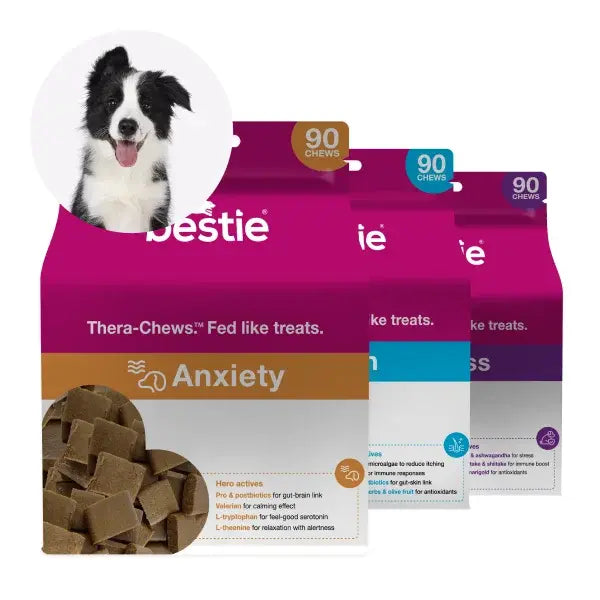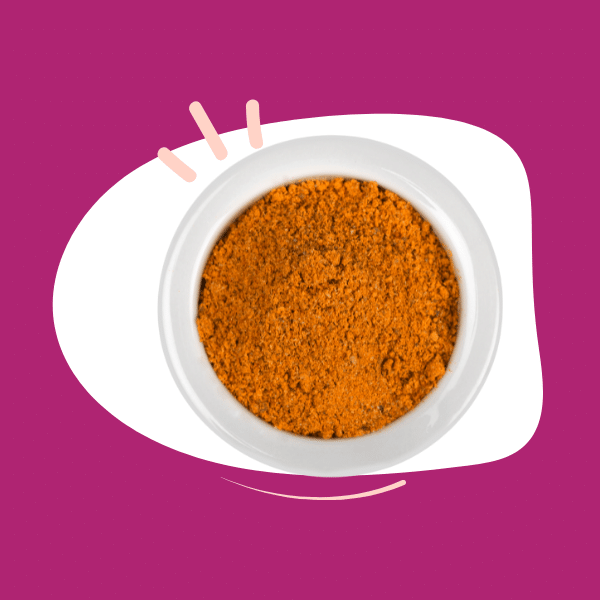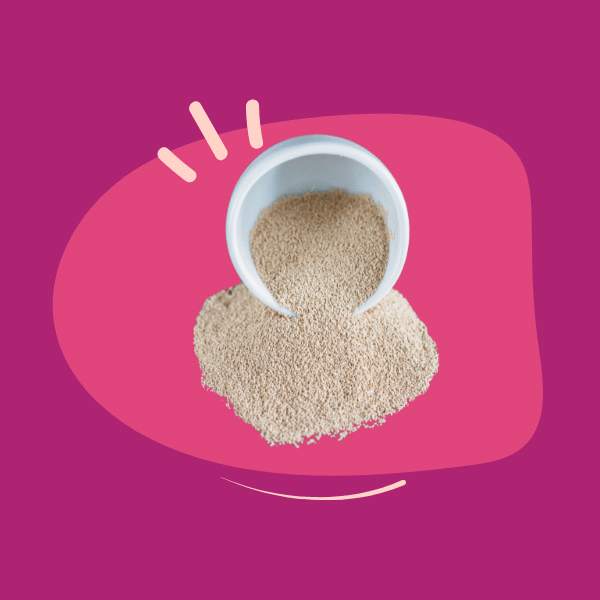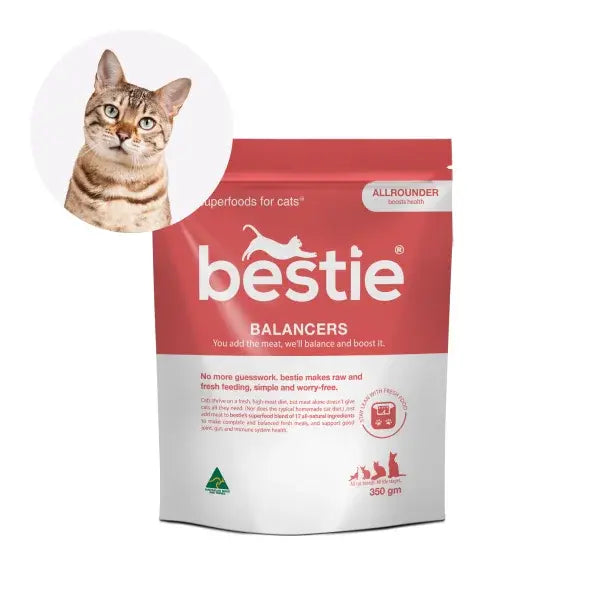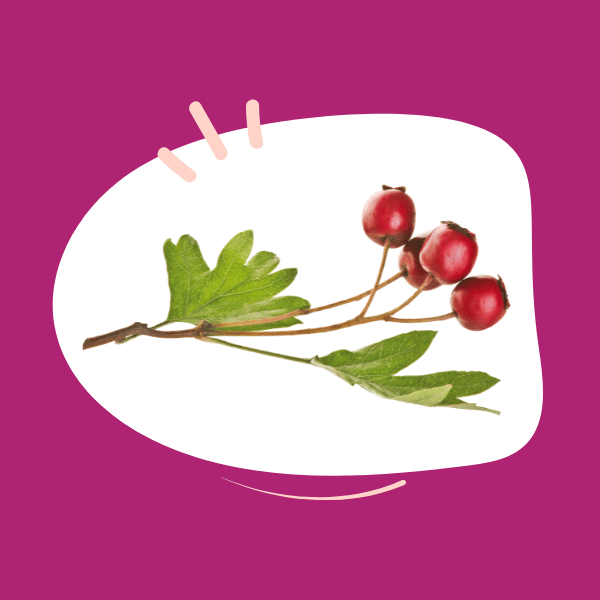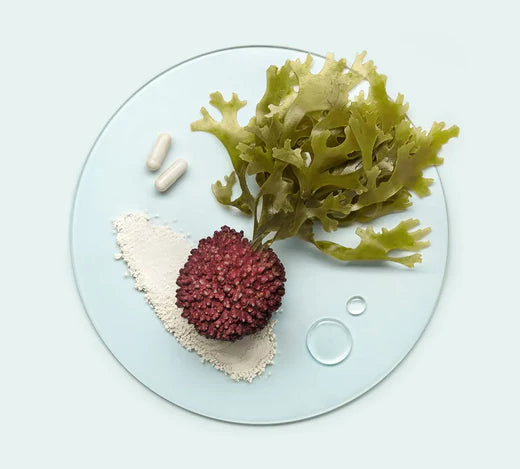Hawthorn is both a medicinal plant and a common edible plant that is widely used as an ingredient of different foodstuffs. The berries, leaves, and flowers of hawthorn have been traditionally associated with many health, medicinal or nutraceutical benefits. Hawthorn is primarily known for its influence on the cardiovascular system.
Chemical analysis has allowed for the identification of more than 150 bioactive molecules in hawthorn, including phenolic acid, quercetin, pyrocatechin, phlorodizin, terpenoids, lignans, steroids, organic acids (fumaric, tartaric, succinic, citric, malic), and sugars (maltose, sucrose, glucose, fructose).1
All these antioxidants make Hawthorn a superfood. And it’s one of the primary ingredients in the Bestie Anxiety health chew - a blend of valerian, tryptophan, l-theanine, pomegranate and hawthorn, that research has shown improves generalised anxiety behaviour and clinical symptoms in dogs.
What is hawthorn?
Hawthorn (Crataegus species) is a thorny shrub that belongs to the rose family. Common species include Crataegus monogyna, Crataegus laevigata, and Crataegus oxyacantha.
Its small white, red, or pink flowers bloom in May. Small berries, called haws, sprout after the flowers. The shiny leaves are in various sizes and shapes.
The berries, leaves, and flowers of hawthorn are phytochemically similar in composition, differing primarily in the ratio of specific flavonoids and procyanidins present.2Hawthorn berries are incorporated in jam, jelly, and many other types of food.
What makes hawthorn a superfood?
Hawthorn is packed with antioxidant flavonoids and a variety of bioactive natural compounds. Extract from its flowers, leaves, and berries have been used in traditional medicine for a very long time. It has been used to treat a wide range of heart problems and other illnesses since the 1st century.
The therapeutic properties of hawthorn are mostly attributed to the rich antioxidant activity of flavonoids that are present in its leaves, fruits, and flowers. The major bioactive compounds in hawthorn are phenolic compounds including phenolic acid, flavonoids, and proanthocyanins. It’s also rich in vitamin C, sugar alcohols, fruit acids, triterpenoids, and some other components that have beneficial effects on human and animal health.
Antioxidants are substances that act against compounds (free radicals) that cause damage to the body cells and even cause cell death. Free radicals occur naturally in the body. Exposure to environmental toxins, such as radiation, smoking, air pollution, etc. can also increase the number of free radicals in the body. These harmful compounds have been implicated in various medical conditions, including heart disease and cancer.
How does hawthorn work?
The extracts of hawthorn fruits and leaves have multiple health effects including hypolipidaemic, anti-atherosclerotic, hypotensive, cardioprotective, and blood vessel-relaxing activities. Hawthorn fruit extracts have also displayed antioxidant and radical scavenging activities.3They also help stop some of the damage caused by free radicals.
Anxiety
The development of anxiety is fuelled by many factors. Exposure to stressors, decline in cognitive function or memory in senior dogs, and inflammation in the body have all been recognised as important predisposing factors of anxiety.
When there is not enough antioxidants in the body, the increase in the levels of free radicals and reaction oxygen species (ROS) remains unchecked. This can eventually lead to an inflammatory process in the body.
Inflammation has been shown to increase feelings of anxiety as it affects the anxiety-related regions of the brain. A study was able to demonstrate the role of inflammation on disorders fuelled by stress and anxiety. Researchers observed that as the level of inflammatory markers increased, so did the feelings of anxiety.20
The antioxidants in Hawthorn can help alleviate symptoms of anxiety and inflammation by detoxifying the reactive oxygen species (ROS) and free radicals that fuel the inflammatory process thereby restoring homoeostasis in the body.
Heart disease
Both animal and human studies have been able to demonstrate the beneficial effects of hawthorn on the heart and circulatory system. With its ability to reduce important risk factors such as inflammation, hypertension, and thrombosis, hawthorn can help improve blood circulation, lower blood pressure, and significantly improve heart function.
The cardiovascular effects are believed to be the result of positive inotropic activity, the ability to increase the integrity of the blood vessel wall and improve coronary blood flow, and positive effects on oxygen utilization. 4These effects are attributed to hawthorn’s high flavonoid content.
Compared to digitalis (a common heart medication), hawthorn has a wider therapeutic range, lower risk in case of toxicity, has less of an arrhythmogenic potential, is safer to use in renal impairment, and can be safely used with diuretics and laxatives.5
Consumption of hawthorn can alter the cholesterol metabolism of the liver, increases hepatic LDL receptor activity, and reduce blood lipid and cholesterol levels. In addition, the abundant amount of antioxidants contained in hawthorn can protect LDL from oxidation, thus slowing down the development of atherosclerosis.6
Diabetes
Extract from hawthorn seeds exerts a hyperglycaemic effect on diabetic gastroparesis and can prevent weight loss to some extent.7
Hawthorn supplementation in pre-diabetes patients who are on metformin showed that the combination is more effective compared to metformin alone. The combination treatment could significantly reduce body weight, insulin resistance, and hs-CRP levels, and regulate glucolipid metabolism.8
Wound healing
Hawthorn can accelerate wound healing and the time taken for complete healing of damaged skin in superficial skin wounds.9 The beneficial effects may be attributed to its flavonoid content.
Hawthorn can also be used to treat skin problems such as boils and skin sores.
Metabolic syndrome
Patients with metabolic syndrome possess risk factors that may include at least three unhealthy medical conditions such as high blood sugar, hypertension, or obesity occurring simultaneously. These patients have higher risks for cardiovascular diseases and diabetes mellitus. Various studies have shown that C. pinnatifida can have beneficial effects on controlling and treating high blood sugar, dyslipidemia, obesity, and atherosclerosis.10
Cholesterol
Hawthornextract antagonizes the increases in cholesterol, triglyceride, and phospholipid levels in low-density lipoprotein (LDL) and very low-density lipoprotein.11 It also prevents cholesterol accumulation in the liver by enhancing cholesterol degradation to bile acids, as well as suppressing cholesterol biosynthesis.12
Pectin extracted from hawthorn fruit reduces the risk of cardiovascular disease by binding cholesterol and bile acids to promoting their excretion in the feces.13
Anti-ageing
Hawthorn extract can decrease skin roughness, improve the appearance of wrinkles, and has moisturising effects. It can also protect against UVB-exposed photoaging of the skin.14
Antibacterial, antifungal, and antiviral
Antimicrobial activity of hawthorn extract has moderate bactericidal activity, especially against Gram-positive bacteria such as Micrococcus flavus, Bacillus subtilis, and Listeria monocytogenes.15
The flavonoid and procyanidin compounds in the extract are also highly effective against Candida albicans (a type of fungus) and the Herpes simplex virus.16.
Gastroprotective
Hawthorn is an ideal supportive treatment for gastrointestinal disease. It also stimulates digestion and promotes stomach function.
Depression
Chlorogenic acid (CGA) from the extract of hawthorn fruit have antidepressant effects and thereby have potential as natural antidepressants.17
Chemotherapy toxicity
Many drugs cause various types of toxicities in the body. Hawthorn extract has been shown to treat drug-derived toxicity associated with particular anticancer drugs. 18
Scurvy
Substantial quantities of vitamin C in Hawthorn fruit can help prevent or treat scurvy, a condition caused by vitamin C deficiency.
Hawthorn for pets
A number of experimental studies performed on animals, show extracts of hawthorn can increase cardiac contractility, increase cardiac blood flow and decrease blood pressure.19
Hawthorn benefits pets with kidney failure as it causes dilation of the blood vessels which can increase circulation to the kidneys.
Supplementing your senior pet’s diet with hawthorn is a great way to combat many important age-related issues. Daily intake can also help dogs recover from infections and also counteract the effects of chemotherapy.
Hawthorn can also help ease anxiety and depression. If your pet suffers from separation anxiety, fear-related anxiety, or age-related anxiety, The Bestie Anxiety is specially formulated to help reduce stress and anxious behaviour.
According to the ASPCA, Hawthorn is non-toxic to dogs and cats. However, pets, like people, tend to differ in their responses. If it’s your pet’s first time to be on a hawthorn-supplemented diet, do monitor for any reactions that should be brought to the attention of your veterinarian. If your pet is on certain medications, you should ask your veterinarian before starting your pet on any supplement.
List of References:
- Amirhossein Nazhand et al. Hawthorn (Crataegus spp.): An Updated Overview on Its Beneficial Properties. May 2020Forests 11(5):564. DOI:10.3390/f11050564
- Mary C. Tassell, Rosari Kingston, Deirdre Gilroy, Mary Lehane, and Ambrose Furey. Hawthorn (Crataegus spp.) in the treatment of cardiovascular disease. Pharmacogn Rev. 2010 Jan-Jun; 4(7): 32–41. doi: 10.4103/0973-7847.65324]
- Pengzhan Liu. Composition of Hawthorn (Crataegus spp.) Fruits and Leaves and Emblic Leafflower (Phyllanthus emblica) Fruits.
- Rigelsky J.M., Sweet B.V. Hawthorn: Pharmacology and therapeutic uses. J. Health Syst. Pharm.2002;59:417–422.
- Schulz, R. H nsel, V.E. Tyler, Rational phytotherapy: a physician's guide to herbal medicine, Routledge, 2001.
- Jun Yan Han, De Hong Tan, Guang-Chun Liu. Hawthorn - A Health Food. November 2011Applied Mechanics and Materials 140(2):350-354DOI:10.4028/www.scientific.net/AMM.140.350
- Niu, Z.; Yan, M.; Zhao, X.; Jin, H.; Gong, Y. Effect of hawthorn seed extract on the gastrointestinal function ofrats with diabetic gastroparesis. Afr. J. Bot. 2020,130, 448–455.
- Zhi-qiang Gao, Meijuan Xie, Xing-yue Huang. Effects of combination treatment of metformin and hawthorn in patients with prediabetes complicated by nonalcoholic fatty liver disease.
- Kalantari, H.; Hemmati, A.A.; Foruozandeh, H.; Kalantar, M.; Aghel, N.; Aslani, M.; Ehsan, T. Healing Effectof Hawthorn (Crataegus pontica C. Koch) Leaf Extract in Dermal Toxicity Induced by T-2 Toxin in Rabbit.Jundishapur J. Nat. Pharm. Prod. 2016,11, e35688.
- Dehghani, S.; Mehri, S.; Hosseinzadeh, H. The effects of Crataegus pinnatifida (Chinese hawthorn) on metabolicsyndrome: A review. Iran. J. Basic Med. Sci. 2019,22, 460–468.
- Shanthi SParasakthy KDeepalakshmi PDDevaraj SN Hypolipidemic activity of tincture of Crataegusin rats. Indian J Biochem Biophys. 1994;31143- 146
- Rajerdan SDeepalakshmi PDParasakthy KDevaraj HDevaraj SN Effect of tincture of Crataeguson the LDL-receptor activity of hepatic plasma membrane of rats fed an atherogenic diet. 1996;123235- 241
- Zhu, R.G.; Sun, Y.D.; Hou, Y.T.; Fan, J.G.; Chen, G.; Li, T.P. Pectin penta-oligogalacturonide reducescholesterol accumulation by promoting bile acid biosynthesis and excretion in high-cholesterol-fed mice.Chem. Biol. Interact. 2017,272, 153–159.
- Hwang, E.; Park, S.Y.; Yin, C.S.; Kim, H.T.; Kim, Y.M.; Yi, T.H. Antiaging effects of the mixture of Panax ginsengand Crataegus pinnatifida in human dermal fibroblasts and healthy human skin. J. Gins. Res.2017,41, 69–77.
- Barros L., Dueñas M., Carvalho A.M., Ferreira I.C., Santos-Buelga C. Characterization of phenolic compounds in flowers of wild medicinal plants from Northeastern Portugal. Food Chem. Toxicol.2012;50:1576–1582. doi: 10.1016/j.fct.2012.02.004.
- Orhan I. HPLC Quantification of vitexine-2”-O-rhamnoside and hyperoside in three crataegusspecies and their antimicrobial and antiviral activities. Chromato Suppl.2007;66:153–7.
- Lim, D.W.; Han, T.; Jung, J.; Song, Y.; Um, M.Y.; Yoon, M.; Kim, Y.T.; Cho, S.; Kim, I.H.; Han, D.; et al.Chlorogenic Acid from Hawthorn Berry (Crataegus pinnatifida Fruit) Prevents Stress Hormone-InducedDepressive Behavior, through Monoamine Oxidase B-Reactive Oxygen Species Signaling in HippocampalAstrocytes of Mice. Mol. Nutr. Food Res. 2018, e1800029.
- Seyed Fazel Nabavi, Solomon Habtemariam, Touqeer Ahmed, Antoni Sureda, Maria Daglia,, Eduardo Sobarzo-Sánchez, and Seyed Mohammad Nabavi1. Polyphenolic Composition of Crataegus monogyna Jacq.: From Chemistry to Medical Applications. Nutrients. 2015 Sep; 7(9): 7708–7728. Published online 2015 Sep 11. doi: 10.3390/nu7095361
- Jayalakshmi, C.J. Thirupurasundari, S.N. Devaraj. Pretreatment with alcoholic extract of Crataegus oxycantha (AEC) activates mitochondrial protection during isoproterenol - induced myocardial infarction in rats. Mol Cell Biochem 292 (2006) 59-67.
- Julie Lasselin, Sigrid Elsenbruch, Mats Lekander , John Axelsson, Bianka Karshikoff, Jan-Sebastian Grigole, Harald Engle, Manfred Schedlowski, Sven Benson. Mood disturbance during experimental endotoxemia: Predictors of state anxiety as a psychological component of sickness behavior. Meta-Analysis Brain Behav Immun. 2016 Oct;57:30-37. doi: 10.1016/j.bbi.2016.01.003. Epub 2016 Jan 11.



